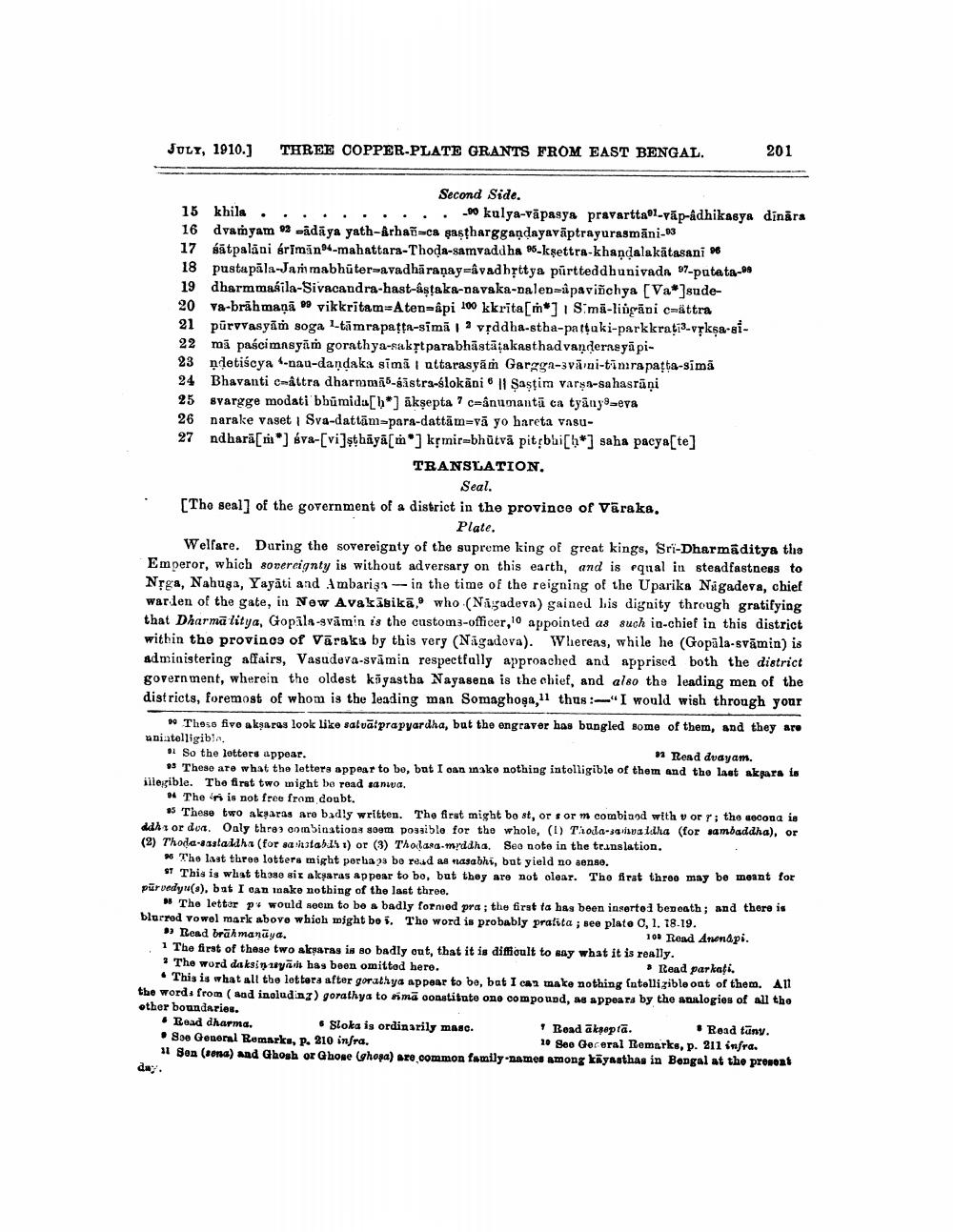________________
JULY, 1910.]
THREE COPPER-PLATE GRANTS FROM EAST BENGAL.
201
Second Side, 15 khila ...........10 kulya-vāpasya pravarttal-vāp-adhikasya dinara 16 dvamyam 2 nädāya yath-arhan-ca şaştharggaņdayavāptrayurasmāni- 17 sātpalāni krimino-mahattara-Thoda-samvaddha 96-kşettra-khandalakātasani " 18 pusta pāla-Janmabhūter-avadharanay=&vad brttya pürtteddbunivada 87-patatas 19 dharmmakila-Sivacandra-hast-ástaka-navaka-Dalen-paviñchya [Va®]sude20 Ya-brāhmaṇā " vikkritam-Aten-api 100 kkrita[i] 1 Simā-lingani emättra 21 pūrvvasyāt soga 1-tāmrapatta-simā ? vặddha-stha-pattaki-parkkrati3-vrksa-si22 ma pascimneyam gorathya-saktparabhāstājakasthad vanderneyäpi23 ndetiścya -nau-dandaka simã I uttarasyām Garggn-vārni-tinira pagta-simä 24 Bhavanti crittra dharnymi5-găstra-slokāni 11 Şasim var -sa hasrani 25 syargge modati bhūmida[ho] aksepta 7 ceánumantū ca tyānye-eva 26 narake vaset | Sva-dattām-para-dattām=vā yo bareta vasu27 ndhara[m] śva-[vi]şthāyā[m] kşmir-bhūtvā pitbui[h*] saha pacya[te]
TRANSLATION.
Seal. [The seal] of the government of a district in the province of Vāraka.
Plate. Welfare. During the sovereignty of the supreme king of great kings, Sri-Dharmaditya tha Emperor, which sovereignty is without adversary on this earth, and is equal in steadfastness to NȚga, Nahuşa, Yayati and Ambarişi -- in the time of the reigning of the Uparika Nagadeva, chief war.len of the gate, in New Avakasikā, who (Nagadeva) gained lis dignity through gratifying that Dharmā litya, Gopāla-svāmin is the custom3-officer, to appointed as such in-chief in this district within the province of Vāraks by this very (Nāgadova). Whereas, while he (Gopāla-svāmin) is administering affairs, Vasudeva-svāmin respectfully approached and apprised both the district government, wherein the oldest kigastha Nayasena is the chief, and also the leading men of the districts, foremost of whom is the leading man Somaghoşa, thus:-"I would wish through your
* These five akşaras look like salvāłprapyardha, but the engraver has bungled some of them, and they are unistelligible . So the letters appear.
Read duayam. * These are what the lettera appear to bo, but I can inake nothing intolligible of them and the last akuara to illegible. The first two might be read sanwa.
The 'ri is not free from doubt. * These two akşaras aro badly written. The first might bo st, or for combined with v orr; the second is adhu or du. Only thres combinations soem possible for the whole, (1) Thoda-sarivaidla (for sambaddha), or (2) Thoda-aastaldha (for salutabls 1) or (3) Tholasa-mrddha, Seo note in the translation.
* The last three lotters might perha 3 bo read as nasabhi, but yield no senso.
T This is what those sir akşaras appear to bo, but they are not oloar. The first three may be meant for pür vedyw(), but I can make nothing of the last three.
* The letter p' would seein to be a badly fornied pra; the first ta has been inserted beneath; and there is blurred vowel mark above which might be i. The word is probably pralita ; see plato , 1. 18-19. • Read brākmanāya.
101 Read Annapi. 1 The first of these two akwaras is so badly out, that it is difficult to say what it is really. * The word daksinuat has been omitted here.
Read parkati. • This is what all the letters after gorathya appear to be, bat I can make nothing intelligiblo out of them. All the word. from (and including) gorathya to rimä oonstitute one compound, as appears by the analogies of all the other boundaries. • Read dharma. . Sloka is ordinarily masc.
Road akseptā.
Read tūny. • Soe General Remarks, P. 210 infra.
10 See Gereral Remarks, p. 211 infra. 11 Sen (ona) and Ghosh or Ghone (ghopa) are common family names Among kayasthas in Bengal at the presa day.




